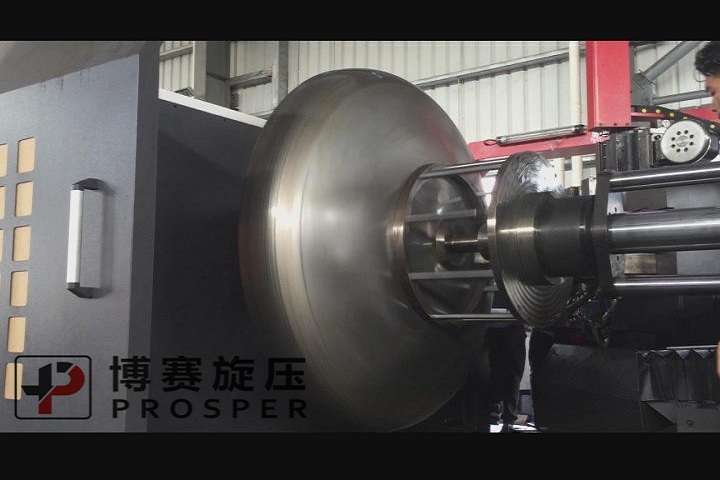Metal Spinning Technical Solution--- Wall Thickness Thinning Rate
Date: Apr,29 2020 View:
Metal Spinning Technical Solution--- Wall Thickness Thinning Rate
There is a certain degree of wall thickness thinning rate (5% to 12%) during the drawing and spinning process of conventional spinning, and its size depends on the performance of the material to be formed, the amount of path and the path of the path (single path or two-way paths). Some important applications and high-pressure-resistant products have greater restrictions on the amount of wall thickness reduction, which is also an important indicator of product quality. For example, the maximum thinning rate of products such as pressure vessel dish ends cannot exceed the upper limit.
In the strong spinning process, the thinning rate is a major process parameter in the deformation zone, because it directly affects the size of the spinning pressure and the quality of the spinning parts.
There are two types of wall thickness reduction rate: total reduction rate and path reduction rate. The total thinning rate is not a simple sum of the thinning rates of each path, but a combination of thinning rates of each path in a certain form. The total thinning rate depends on the arrangement of the spinning process.
Through experimental research and production practice, Prosper has summarized the following experiences of the influence of wall thickness reduction rate.
(1) The total spinning thinning rate of tapered and curved shaped linear shaped parts depends on the semi-taper angleαof the workpiece and the blank shape.
(2) When the thin blank is sheared and spun, the effect of the thinning rate on the accuracy of the workpiece is not significant. As the workpiece half cone angle α decreases and the thinning rate increases, the workpiece accuracy also increases slightly. Therefore, blank forming should be used as much as possible. When the thinning rate exceeds the material limit thinning rate, multi-path shear spinning with intermediate heat treatment or prefabricated blanks are used.
(3) When shearing and spinning of thick blanks, in order to reduce the uneven deformation in the thickness, it is beneficial to increase the accuracy of the workpiece by appropriately increasing the number of spinning.
(4) The thinning rate of shear spinning should not be too small to avoid excessive rebound of the workpiece. Generally, the change of the half-cone angle of the workpiece in each path is preferably not less than 5 °.
(5) The relationship between the accumulation of materials and the wall thickness reduction rate when the cylindrical (tubular) part is strongly rotated decline in quality. When the thinning rate is too large, due to the serious material accumulation, the local deformation under the roller is in an unstable state, which not only greatly increases the spinning pressure, but even makes the spinning impossible.
(6) The thinning rate of the path of the cylindrical part during strong rotation has an influence on the expansion and contraction amount and accuracy of the inner diameter of the workpiece. In the case where the total thinning rate has been fixed, it is often divided into several paths for spinning according to the process conditions and the dimensional accuracy requirements of the workpiece.
(7) Excessive path thinning rate will cause distortion of workpiece and increase accuracy when cylindrical parts are strongly rotated The unevenness of the deformation makes its accuracy worse, and the inner surface of the workpiece is not sufficiently deformed and cracks appear. Usually the path thinning rate can be selected within the range of 15% to 50%. People think that about 25% to 30% is the best value. According to PROSPER's experience, many materials take a thinning rate of 30-40% in a single spinning process (individual materials take 20% -30%). The American AD259022 research report shows that when the thinning rate changes within 30%, the wall thickness deviation and inner diameter deviation of the spinning parts decrease with the increase of the thinning rate; At the same time, the above two deviations increase significantly with the increase of the thinning rate, and the increment is getting larger and larger. It shows that the thinning rate of one spin is preferably about 30%.
(8) The test also shows that when the total thinning rate is a fixed value, the thinning rate of the positive rotation path of the cylindrical (tube-shaped) piece is appropriately reduced (the number of paths is increased), and the thinning rate of the reverse rotation path is appropriate The increase (decrease in the number of paths) is beneficial to improve the precision of the workpiece diameter. In multi-path spinning, the distribution of path thinning rate should also consider reducing the number of spin wheel replacements and spinning machine processing capacity.
(9) When determining the thinning rate in the process design, first consider the rotatability of the blank material and the processing capacity of the equipment. Under the condition of ensuring product quality, a large thinning rate should be used as much as possible to reduce the number of spinning channels, improve production efficiency and obtain a more significant effect of strengthening materials
Prosper CNC metal spinning machine PS-CNCXY1500 is spinning dish end.






